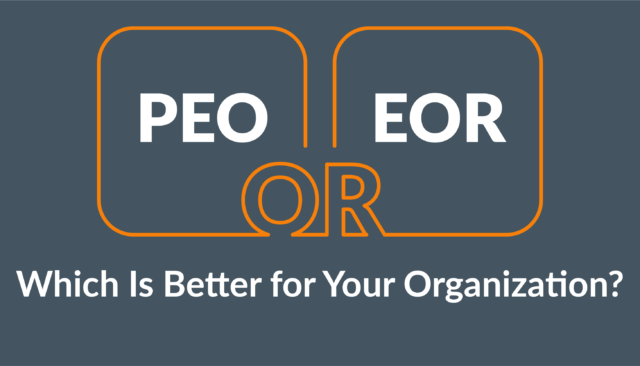
With globalization reshaping business landscapes, international teams are increasingly common.
They offer access to diverse skills and perspectives, promoting innovation and competitive advantage. However, effective onboarding is crucial for new members to adapt quickly and contribute effectively. This blog will explore strategies for successful onboarding in international teams, discussing cultural awareness, communication, onboarding materials, mentoring, orientation sessions, team building activities, knowledge exchange, ongoing support, language and time zone challenges, and the importance of adjusting strategies based on monitoring.
Professional Employer Organization (PEO) and Employer-of-Record (EOR)

In the context of international teams, Professional Employer Organizations (PEOs) and Employer-of-Record (EOR) services can be significant. There is an ongoing PEO vs EOR debate, and that’s why it’s vital to talk about both. PEOs provide comprehensive HR solutions for businesses, helping manage employee benefits, payroll, compliance, and other HR responsibilities. They can be particularly useful when managing international teams as they can handle diverse employment laws and regulations.
On the other hand, an Employer-of-Record (EOR) becomes the legal employer of your overseas workforce. They take on the responsibility of employment compliance, payroll, and benefits. This can simplify the process of hiring and onboarding international team members, and ensure adherence to local labor laws.
Understanding the Cultural Context
Cultural awareness is pivotal when dealing with international teams. Every team member brings their cultural norms, values, and communication styles to the table. Understanding these cultural nuances fosters respect, reduces misunderstandings, and enhances collaboration. Start by researching the cultures of your team members – understand their work ethics, attitudes towards hierarchy and power, preferred communication styles, and so on. However, while it’s essential to be aware of cultural norms, avoid stereotyping. Instead, engage in open discussions about cultural differences, fostering an environment that appreciates and leverages diversity.
Establishing Clear Communication Channels
Communication forms the bedrock of any team, and in an international context, it can be challenging. Clear, effective communication channels need to be established from the onset. This includes choosing appropriate tools that everyone can access and use efficiently – tools like Slack, Teams, Zoom, or Google Meet can be useful. The chosen tools must support various languages and have an easy-to-navigate interface. You should also establish communication etiquette, addressing factors like response times, acceptable language use, and time zone considerations.
Preparing Comprehensive Onboarding Materials

Onboarding materials serve as a roadmap for new members, particularly in an international team where they may be unfamiliar with company culture and processes. These resources should be comprehensive, easily accessible, and updated regularly. They should include not only procedural information, like policies and guidelines but also cultural insights and team-specific instructions. Digital onboarding platforms can offer an interactive and engaging way to deliver these resources.
Assigning Mentors or Buddies
Assigning mentors or buddies to new members aids in acclimatization. These individuals should be culturally aware, patient, and willing to guide newcomers. They can offer insights into team dynamics, workflow, and cultural nuances, all while providing emotional support. Fostering a welcoming and inclusive environment is key in this regard. Regular check-ins between the new hire and their mentor can further strengthen this bond.
Scheduling Orientation Sessions
Orientation sessions offer a comprehensive overview of the team’s goals, roles, and expectations. These should be interactive, allowing new members to ask questions and clarify doubts. Consider the time zone differences while planning these sessions and use a language that is clear and straightforward. Also, ensure the content is culturally sensitive and inclusive.
Facilitating Virtual Team Building Activities

Building team cohesion in an international team is tricky, especially in a virtual setting. Virtual team-building activities can help build rapport and foster collaboration. From online escape rooms to virtual coffee breaks, choose activities that promote cross-cultural understanding and appreciation. Remember, the goal is to make everyone feel included and valued.
Encouraging Knowledge Exchange
Encouraging knowledge exchange is a critical component in the effective operation of international teams. When each member brings their unique skills, experiences, and cultural perspectives to the table, it significantly enhances the team’s capacity for innovation and growth. This kind of collaborative approach, in which everyone is encouraged to share their knowledge, helps foster a strong sense of unity within the team.
To facilitate this exchange, it is beneficial to establish a designated platform—perhaps a collaborative online workspace or a regular virtual meeting—where team members can share their ideas, experiences, and expertise. Moreover, promoting a culture of continuous learning is a key driver of team satisfaction. It not only encourages personal and professional development but also helps everyone in the team feel valued and respected, fostering a shared commitment to the team’s objectives and a sense of shared progress toward these goals.
Offering Ongoing Support and Feedback
In the context of international teams, the importance of offering ongoing support and feedback to new members cannot be overstated. With team members often separated by great distances, different time zones, and cultural differences, regular check-ins and feedback sessions are crucial for maintaining engagement and fostering a sense of belonging among new members. They offer opportunities for new members to raise any concerns, ask questions, and receive guidance, making them feel seen, heard, and supported.
Besides, constructive feedback plays a critical role in skill development and continuous growth. By offering clear, actionable feedback, new members can better understand their strengths and areas for improvement, thus feeling more confident and capable in their roles. Equally important is the recognition of individual contributions. Celebrating success, no matter how small, boosts morale, increases motivation, and strengthens team cohesion.
Addressing Language and Time Zone Challenges

Language and time zone differences pose common challenges in international teams, requiring careful management and thoughtful strategies. Language barriers, in particular, can lead to miscommunications and misunderstandings, potentially affecting team dynamics and project outcomes. To mitigate these barriers, it can be beneficial to offer language support or training where necessary, or even utilize translation software in your communication tools. Communication, whenever possible, should be clear, concise, and considerate, reducing the chance of confusion.
Regarding time zone differences, these can disrupt the flow of work and communication, making collaboration more difficult. Therefore, it’s essential to schedule meetings at times that are convenient for everyone. Recording meetings for later viewing can also ensure that those who couldn’t attend can still access the information. A culture of flexibility and understanding, wherein team members are aware and respectful of each other’s time zones, is crucial in facilitating smooth operations in international teams.
Monitoring Progress and Adjusting Strategies
Lastly, continually monitor the onboarding process. Be open to feedback from new members and adjust strategies accordingly. Use metrics like new hire performance, engagement level, and feedback to evaluate the process’s effectiveness. Remember, onboarding is a journey, and continuous improvement is key.
Professional Employer Organization (PEO) and Employer-of-Record (EOR)
In the context of international teams, Professional Employer Organizations (PEOs) and Employer-of-Record (EOR) services can be significant. PEOs provide comprehensive HR solutions for businesses, helping manage employee benefits, payroll, compliance, and other HR responsibilities. They can be particularly useful when managing international teams as they can handle diverse employment laws and regulations.
On the other hand, an Employer-of-Record (EOR) becomes the legal employer of your overseas workforce. They take on the responsibility of employment compliance, payroll, and benefits. This can simplify the process of hiring and onboarding international team members, and ensure adherence to local labor laws.
Conclusion
Effective onboarding in international teams necessitates cultural awareness, clear communication, comprehensive onboarding resources, mentoring, orientation sessions, team-building activities, knowledge exchange, ongoing support, and strategies to tackle language and time zone challenges. Regular monitoring and adjusting of strategies are also vital for successful onboarding.
The complexities involved in managing international teams can be made manageable by employing these strategies and possibly employing services like PEOs or EORs. Successful onboarding will ensure new team members are not only well-integrated but are ready to contribute effectively to the team’s success.









